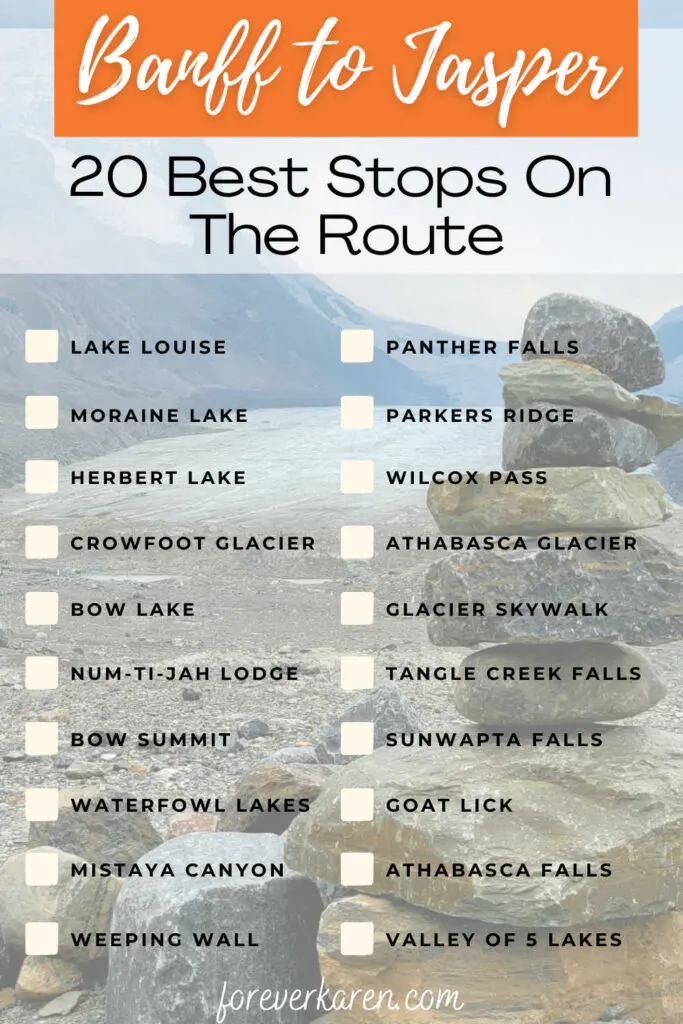
The Icefields Parkways provides a scenic drive from Banff to Jasper. It’s probably one of Canada’s most picturesque drives. The 288 km northwesterly drive starts on the Trans-Canada Hwy/AB-1. However, most of the route travels along Highway 93, also known as the Icefields Parkway.
Once covered in glaciers, today, the landscape offers picturesque lakes, rugged mountains, and jaw-dropping waterfalls. There are few hotels on the Icefields Parkway, so most who drive it either stay in campgrounds or drive it in one day.
It takes nearly 3-1/2 hours (without stopping) to reach Jasper during the summer months. But, you’ll want to stop. To include as many stopping points as possible, plan to get an early start to make the most of your day.
The Icefields Parkway is best enjoyed at your leisure. Since there are few services along the way, remember to fill your tank before driving to Jasper from Banff.
Since you’ll be driving through two national parks, you’ll need a Discovery Pass (park pass), which is mandatory. You can plan to spend five days in Banff and thee to four days in Jasper.
Driving The Icefields Parkway In Winter
While this guide is written for making the journey in summer, you can drive in winter too. Making the drive in winter can make for a challenging road trip. It’s mandatory to have snow tires, and ideally, you’ll want an SUV.
Check the weather forecast and road conditions before setting out. Pack supplies, food, and water, in case of an emergency.
While it takes 3-1/2 hours to make the drive in summer, bad weather and slick road conditions can make the journey much longer in the winter. Plan for up to double the driving time.
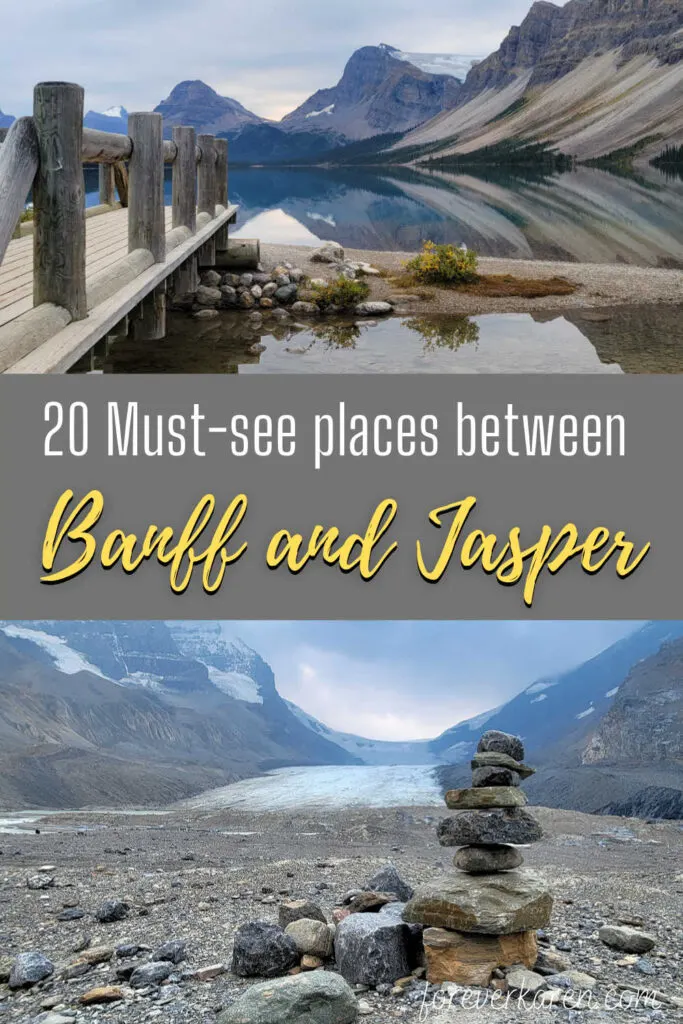
In winter, there are few options to stop since pullouts aren’t generally plowed, and some places have closed for the season.
So, here are the best stops to enjoy the scenery and experience the Canadian Rockies in the summer months.
1. Lake Louise
The world-renown Lake Louise offers some of Banff’s best hikes. Who can resist a cup of fresh tea at the Lake Agnes tea house or the views from the back of the lake?
As Banff’s most visited lake, expect crowds and parking problems in peak times. During the summer, visitors can rent a canoe for a unique perspective of the area.
To beat the crowds, plan to show up by dawn so you can secure a parking spot. Also, the mornings are the optimal time for taking photos. As the day progresses, the sun casts shadows on the lake.
In winter, the icy playground offers ice skating, sleigh rides, ice climbing, snowshoeing, and cross-country skiing. I recommend getting accommodation in Banff or Lake Louise for a few days to enjoy the area.

If you’re planning to make this drive in winter, I suggest staying at Lake Louise. In winter, Lake Louise cuts down the drive and puts you a bit closer to Jasper National Park.
2. Moraine Lake
Located close to Lake Louise, Moraine Lake might arguably be the most photographed Banff lake. In the morning, the sunrise over Moraine Lake is spectacular and creates unforgettable memories.
During the summer, the water radiates a vibrant turquoise color, which looks terrific against the mountainous backdrop.
Recently, Parks Canada closed the road to Moraine Lake, making visitation much more difficult. However, Moraine Lake Bus Company, locally owned and operated, offers daily shuttles, sunrise departures, and easier than booking with Parks Canada.
Like Lake Louise, travelers can rent canoes or enjoy one of the many hikes in the area. It’s important to note that Moraine Lake is not accessible in winter due to heavy snowfall.
3. Herbert Lake
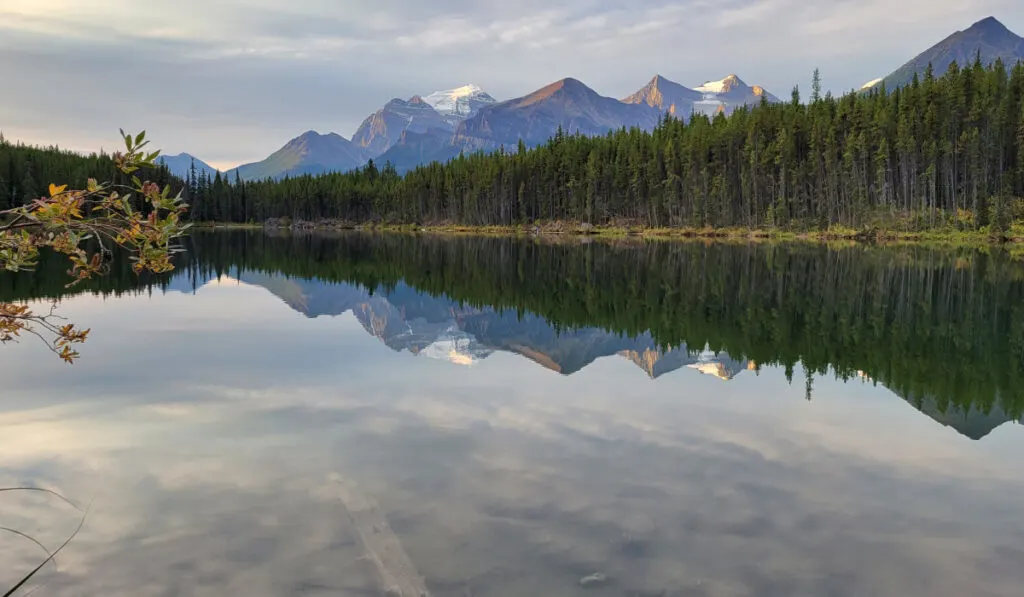
Just off the Icefields Parkway, Herbert Lake offers mirror reflections if the weather conditions are right. Visitors may find this small sink lake perfect for swimming, canoeing, or picnicking.
Due to its size and depth, locals prefer its warmer waters to other glacier-fed lakes.
This lake is undeveloped and a nice change from the populated attractions such as Moraine Lake and Lake Louise.
4. Crowfoot Glacier Viewpoint
The Canadian Rockies are home to numerous valley glaciers. Crowfoot Glacier is a fine example of one, which hangs beneath Crowfoot Mountain. It gained the name from its three hooked toes, resembling a crow’s foot.
Situated at one end of Bow Lake, the waters beneath narrow as the waters channel into Bow River. Be sure to stop further down the road for more impressive views of the lake.
5. Bow Lake
As one of the largest lakes in the Canadian Rockies, visitors can enjoy views from several viewpoints. Firstly, at Crowfoot Glacier, this stop alongside the highway, and one further down, at Bow Lake Lodge (formerly Num-Ti-Jah Lodge).
With no wind, visitors can enjoy mountain reflections in the turquoise waters. In the far distance, to the right, you’ll see the red rooftop of the nearby lodge.
I visited Bow Lake in the peak of the summer, fall, and December. In September, it was gorgeous as the landscape exuded yellow, orange, and red tones.
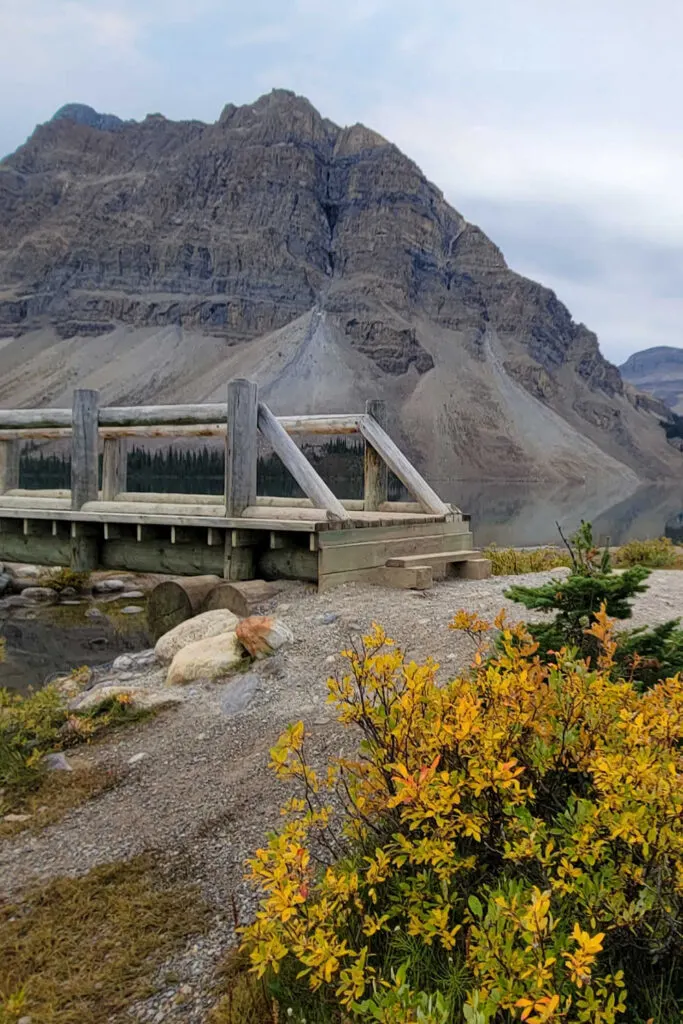
Of course, winter allows travelers to see Bow Lake in a different light. With everything covered in glistening white snow, it looked like a completely different place.
6. Bow Lake Lodge
While the lodge was closed for three years due to the pandemic, it plans to reopen in 2023. Whether you choose to stay or not, the hotel has plenty of parking and offers a starting point for some great hiking.
Take a stroll to the lake from the parking lot, crossing a picturesque bridge. Here, you can see some valley glaciers and Bow Glacier Falls in the distance.
Hiking is available year-round, with the trek to this Banff waterfall being the most popular.
7. Bow Summit (Peyto Lake Viewpoint)
To see Peyto Lake, take the exit for Bow Summit, which is the highest point on the Icefields Parkway. In summer, the area is a frenzy of people coming and going.
It’s a short 15-minute walk to the lookout, and although busy, it’s definitely worth a stop. Undoubtedly, one of Banff’s nicest lakes, Peyto Lake, mesmerizes visitors with its turquoise hues and wolf’s head shape.
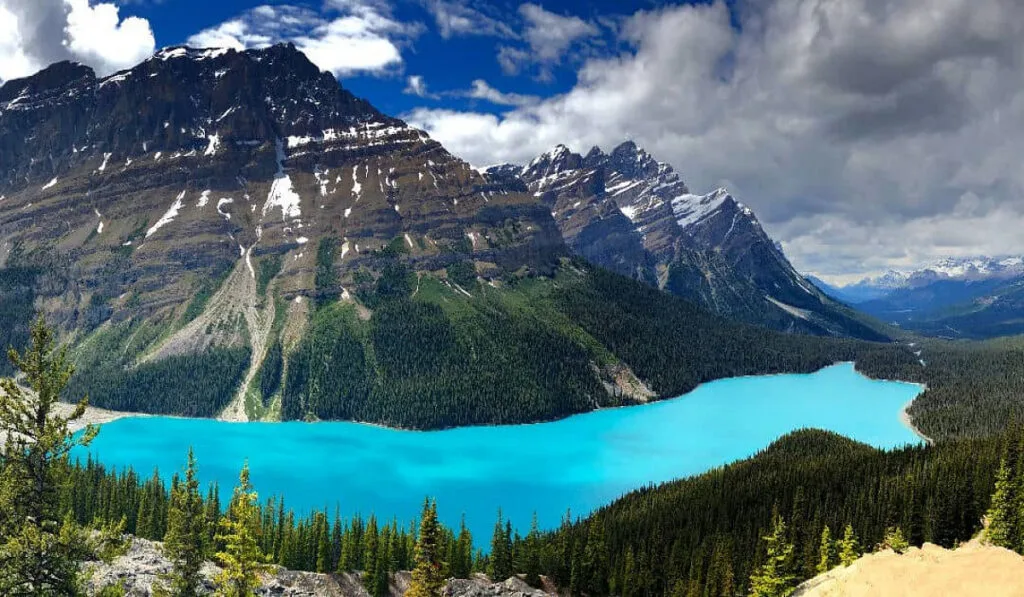
Peyto Lake parking lot was closed for a year as it underwent an upgrade. They expanded the parking area and renovated the washrooms.
If you plan to see Peyto Lake in winter, It can be a bit more challenging to find the viewpoint. Since you could no longer see a trail through the trees, we wandered blindly.
During our December vacation, visitors created narrow trails through the deep snow. Like sheep, we followed other people on several wrong trails that meandered through the trees.
While many gave up searching for the lookout, we proceeded onwards, finding a trail that took us to the upper parking lot (which was closed in winter) and onto the lookout.
Be cautious when hiking here because you can sink into four feet of snow if you step off the flattened trail.
8. Waterfowl Lakes
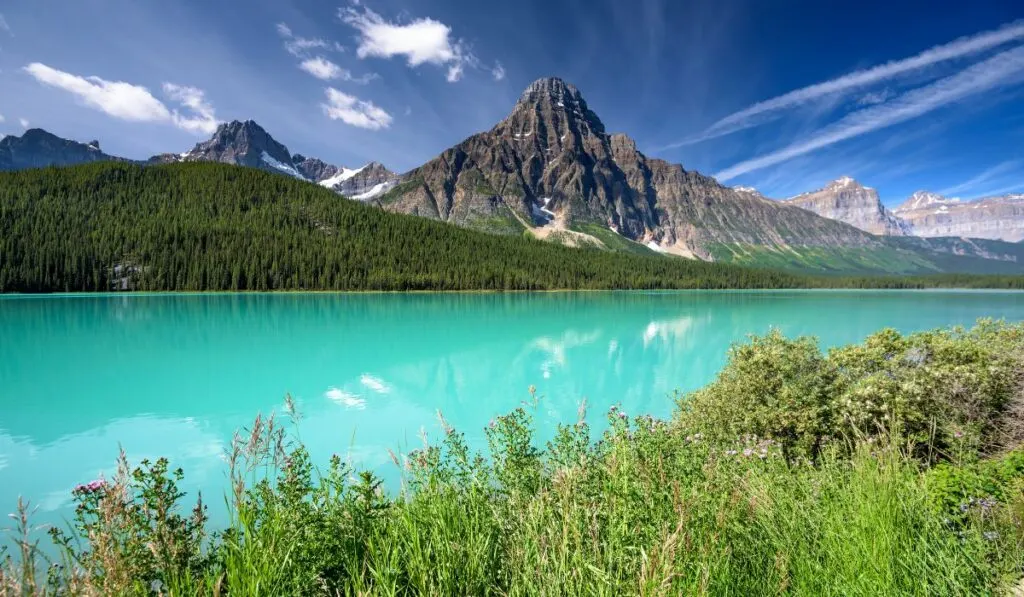
Although not as popular as other roadside lakes, Waterfowl Lakes offer beautiful lakes with incredible mountain views. At the Lower Waterfowl Lake viewpoint, you’ll enjoy the vistas of two iconic peaks
Mount Chephren, a pyramid-shaped mountain, stands on the right, and Howse Peak on the left. Both tower above the lake at heights of over 3,200 meters (10,700+ feet).
Unlike Peyto Lake, Waterfowl Lakes do not display a vibrant turquoise color. The abundance of rock flour, which creates the beautiful tones, is deposited upstream in other lakes.
9. Mistaya Canyon
The Canadian Rockies have some spectacular canyons. However, Mistaya Canyon is the only one found along the Icefields Parkway.
To reach the limestone canyon, visitors must hike a 500-meter downhill trail at the north end of the parking lot. The short hike offers a big reward.

It’s a leisurely 10-minute stroll to the wooden bridge that spans the canyon. Take care at the canyon because the area is unfenced and potentially hazardous.
By the narrow gorge, you can witness how the rushing waters have carved out the limestone rock, creating a smooth-sided deep canyon. The swirling action of the water has created some almost perfect potholes.
Mistaya Canyon is not accessible in the winter months.
10. The Weeping Wall
During the summer, the limestone cliffs of Cirrus Mountain weep with water. The runoff creates dark staining on the sheer cliff, giving its name. The water slowly dries up as summer progresses, and visitors may not see much by fall.
However, the icy sheets of ice invite ice climbers to ascend the cliff on a day outing in winter. While visitors won’t find a Weeping Wall route marker on the highway, it’s hard to miss on the east side when traveling north from Banff to Jasper.
11. Panther Falls
Rarely found by visitors, Banff conceals its highest waterfall in the forest, a short walk from the highway. The 1 km hike rewards travelers with a thundering torrent called “Panther Falls.”
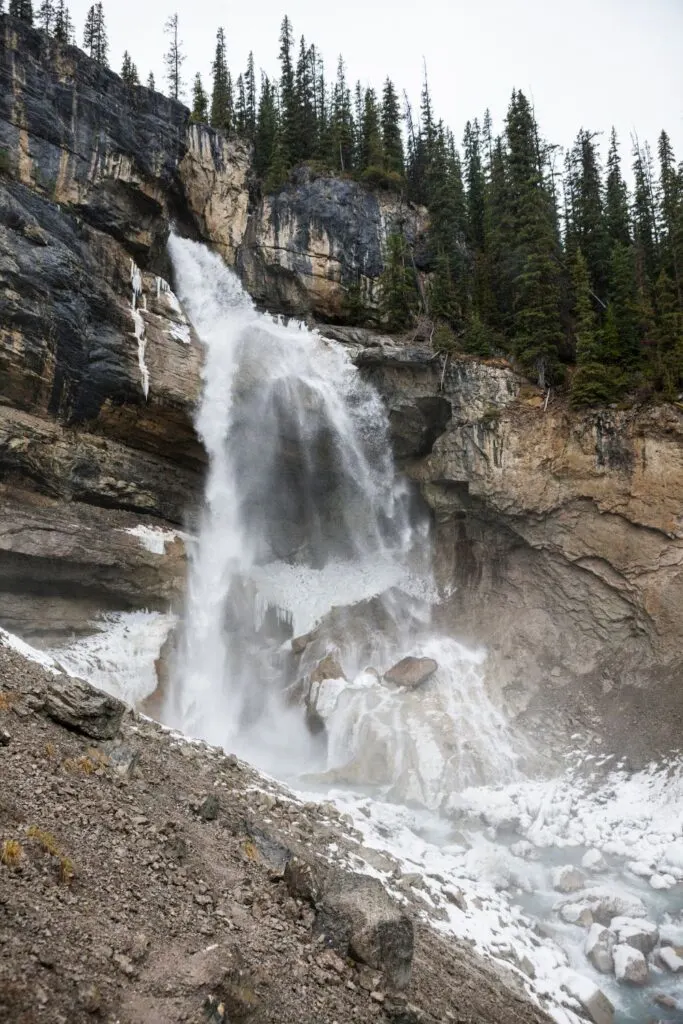
The trail starts at the parking lot’s lower end and descends into the trees. This stop included a “two-for-one” as visitors can view Bridal Veil Falls across the valley.
More serene than Panther Falls, its wispy cascade ranks as Banff’s second-highest waterfall.
12. Parkers Ridge Trailhead
Undoubtedly one of Banff’s best hikes, the Parkers Ridge trail takes hikers above the tree line for amazing views of Saskatchewan Glacier. At 2.4 km (1.5 miles) and an elevation gain of 250 meters (820 feet), the trail reminded me of an outdoor Stairmaster workout.
While the trail starts relatively leisurely, it soon turns into a series of switchbacks. You’ll see different climatic zones during the hike before reaching the summit.
During the summer, the trail gets very busy. To avoid rush hour, the best time to go is before dawn, as you’ll enjoy the trail to yourself.
At the ridge, life is harsh as vegetation struggles to survive a short growing season. So, watch your footing, and avoid stepping on plants or scrubs.
Bring some compact binoculars on the hike, as you might see Bighorn sheep, mountain goats, or golden eagles.
If you want to get closer to the ice, the trip involves a long hike to Saskatchewan Glacier’s toe. However, you may not access the ice, depending on the route you choose.
13. Wilcox Pass Trailhead
Those traveling to Jasper from Banff often stop at the Columbia Icefields. However, I recommend hiking the Wilcox Pass trail for a unique perspective of the icefields. The 8 km roundtrip path starts with a steady climb but flattens out at the meadows.
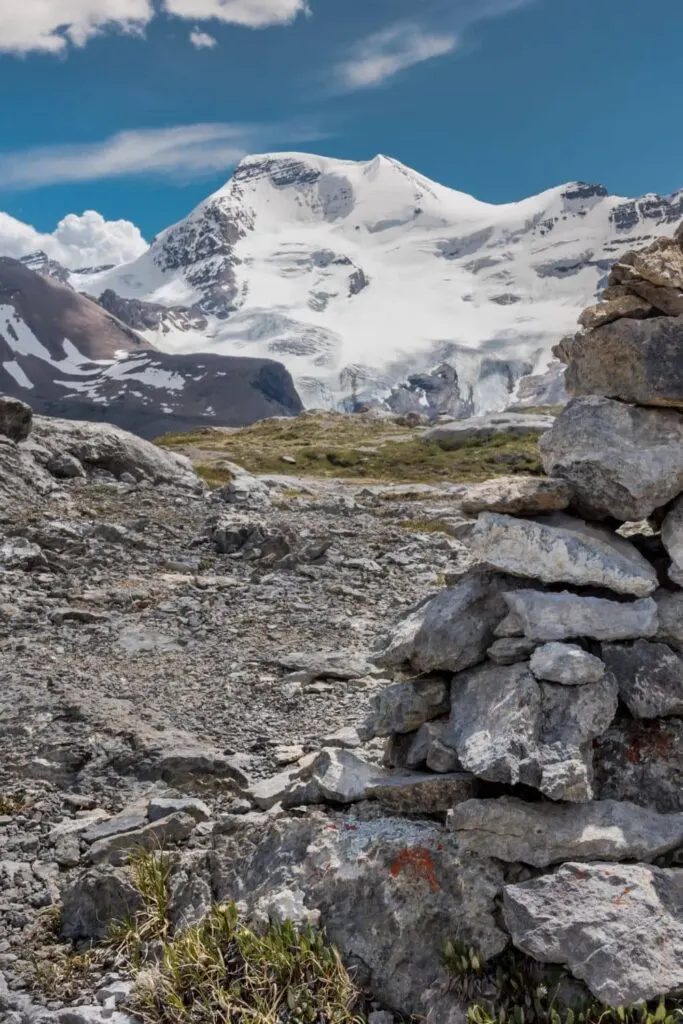
The trail starts in the Wilcox Creek campground, Jasper’s best campground, with a view. If you’re planning to do lots of hiking or have too many stops on your drive, camping part way means you can enjoy the drive and make your planned stops.
The Wilcox Pass trail has come incline, but once you hike above the tree line, you’ll enjoy views of Mount Athabasca and Athabasca Glacier.
No matter what the weather forecast, take a jacket. It can get breezy and cold on the ridge as the winds blow over the glaciers across the valley.
Also, in the meadows, hikers can see Bighorn sheep. Even if you do not make it to the viewpoint, the views above the trees are spectacular.
14. Athabasca Glacier
Visitors to the Columbia Icefields don’t necessarily need to take a tour to see the glacier, although it’s well worth the expense. A road on the west side leads to a parking area near the Athabasca Glacier’s toe.
Here, you can take a short but rewarding hike to the edge of the ice. Be sure to bundle up as the winds off the icefield are frigid. Along the way, you’ll learn about Athabasca Glacier’s retreat and date markers show where the ice use to be.
Like many of the glaciers in the Canadian Rockies, Athabasca Glacier is retreating at an alarming rate.
Know that when you walk on the rocky terrain, you’re stepping where the glacier used to be.
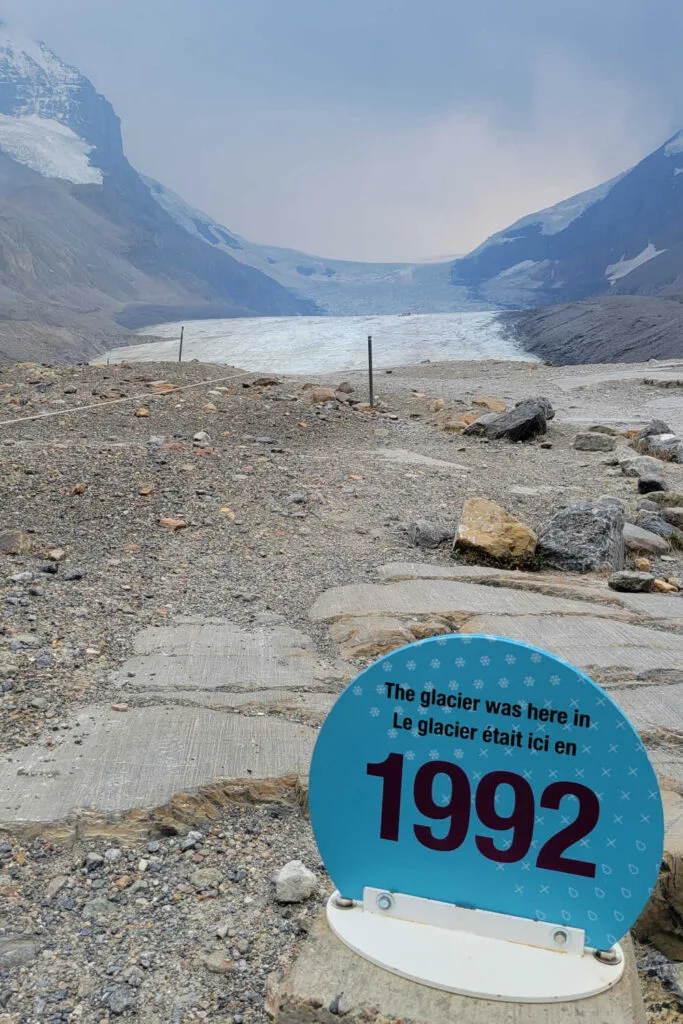
In winter, you’ll need snowshoes or crampons to make the trek. While there’s no trail to follow, you can look ahead in the direction of the glacier.
If you prefer to go onto the glacier, the icefields opens for tours from early May to early October, dependent upon weather.
When taking a tour, you’ll take a big-wheeled bus onto the glacier. A section of the glacier has been groomed to fill in crevices, which allows guests to walk within a roped area.
Walking on the ice gives you a closer look at a glacier, and it’s surprising not as smooth as you’d think. If you bring a water bottle, you’ll have a chance to taste the icy glacial water from a nearby stream.
15. Columbia Icefields Skywalk
Opened in 2014, the Glacier Skywalk projects out over the Sunwapta Canyon and offers unique area views. To walk the glass floor cantilevered platform, visitors must purchase a ticket from the Icefield Center across from the Columbia Icefields.
You can buy a single pass or get a combination ticket that includes a bus ride onto the glacier. Skywalk’s glass floor allows for some fun selfies 280 meters above the canyon.
The walkway to the glass platform has great information on the construction of the Skywalk. It took 20 companies to build. The platform extends 115 feet from the cliff’s edge, and was built 918 feet above the canyon floor.
If you’re fearless, look down, and you could spot some mountain goats who shelter under the structure. Since golden eagles prey on young mountain goats, the animals use the Skywalk to protect their young.
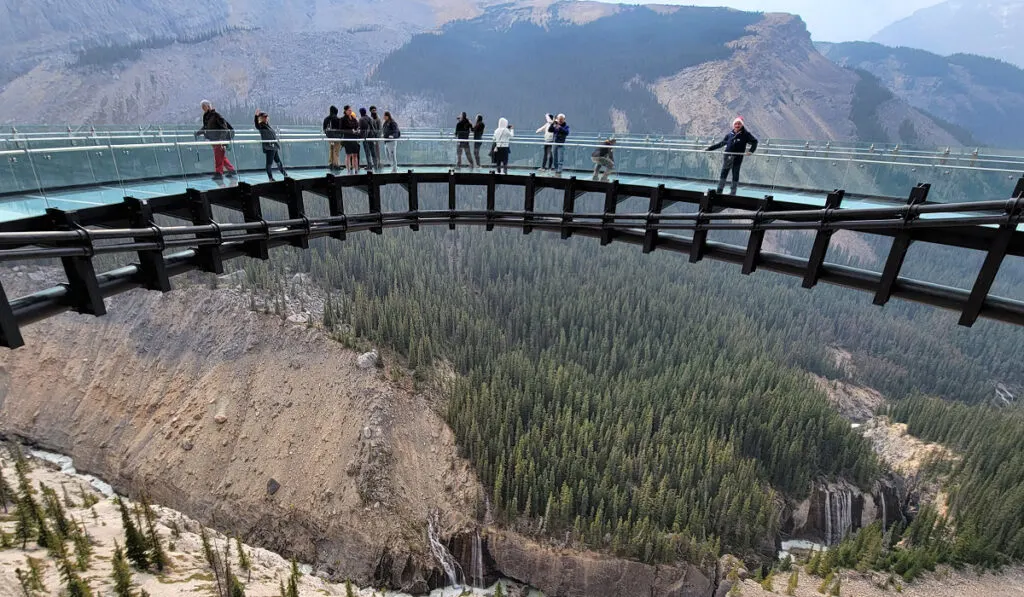
On the walk, you’ll learn about the other animals that call this area home, see cascading waterfalls, and beautiful artwork. During peak season, visitors should book their tickets in advance.
16. Tangle Creek Falls
While visitors can see Tangle Falls from the roadside, they can get closer by taking a short walk. However, park-goers need to park on one side and cross Highway 93 to access the short trail.
The waterfall is picturesque year-round. In summer, it cascades gently down the limestone cliff. But, in winter, the frozen façade becomes popular amongst ice climbers who try to tackle its ice columns.
17. Sunwapta Falls
Visitors to Jasper National Park can see two impressive waterfalls from the Icefields Parkway. Driving north, you’ll reach Sunwapta Falls first, followed by Athabasca Falls, both south of the town of Jasper. It’s a short walk from the parking lot to the Upper Falls.

A bridge crosses the canyon at the falls, allowing for splendid views of the water’s torrent and surrounding mountains. Sunwapta Falls are fed by the Athabasca Glacier seen on a previous stop.
Those wanting to stretch their legs might want to hike to the Lower Falls 1.3 km downstream. Although not as impressive as the Upper Falls, they’re still worth a look.
18. Athabasca River Viewpoint And Goat Lick
An elevated picnic area on the side of Highway 93 offers a chance to see mountain goats. Emphasis on the word “chance!” While I have seen many goats on previous trips, I did not see any on the two times I stopped there last time.
Looking down into the valley, I enjoyed fantastic views of the Athabasca River. Its swirling water has created islands on the valley floor. The towering mountain range behind it makes for a picture-perfect postcard.
At the viewpoint, the cliffs below attract mountain goats and sometimes Bighorn sheep, who enjoy the mineral lick. Salt and minerals are essential to building muscle and bone, so these mineral licks play a vital role in the ecosystem.
19. Athabasca Falls
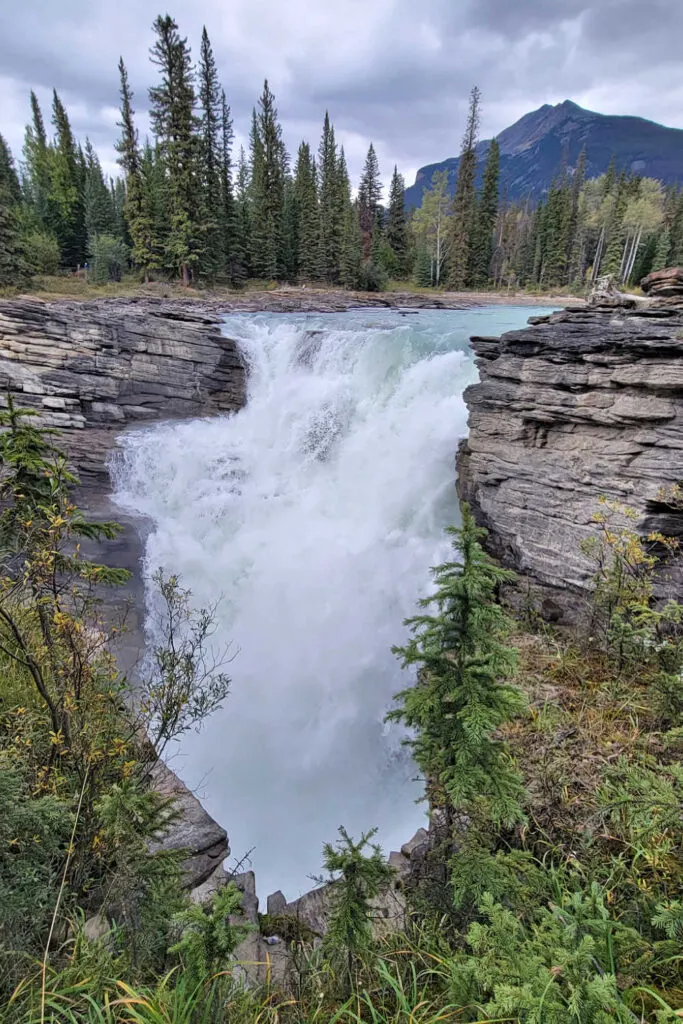
Like Sunwapta Falls, Athabasca Falls is a must-see in Jasper National Park. Its thunderous and powerful volume of water exceeds the former waterfall.
During the summer, the roadside attraction attracts crowds of people who come to witness this natural wonder.
Plan to spend some time crossing several bridges, walking up and downstream to different vantage points. Be sure to follow the trail to the lower canyon.
Here, you’ll walk through an ancient canyon, see a large pothole, and watch the water exit into a wider channel.
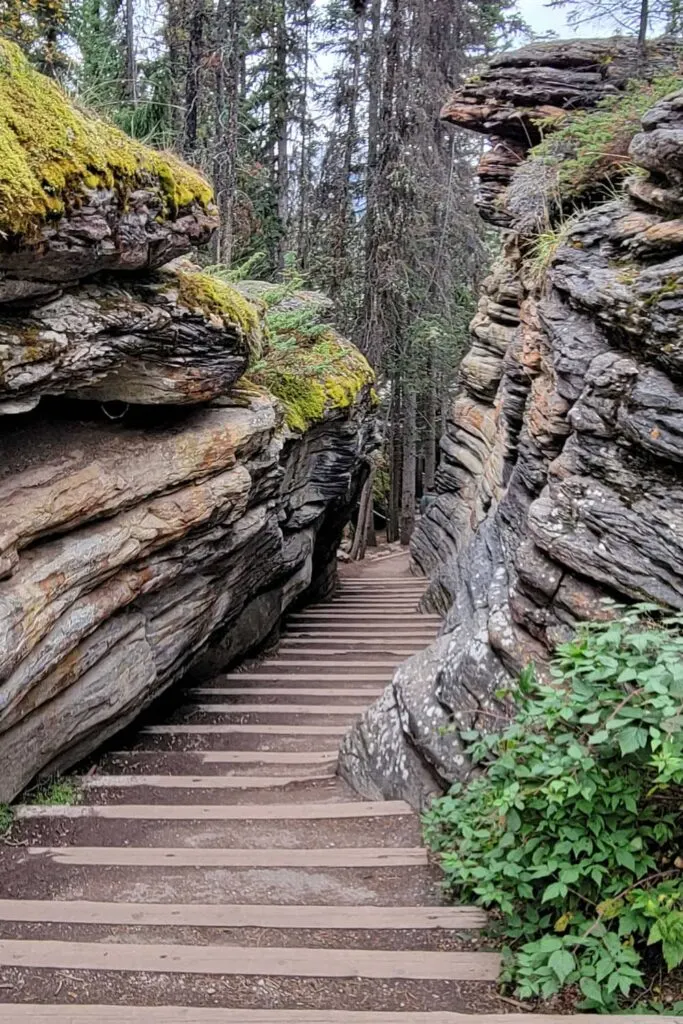
The water changes color depending on the season. In summer, the abundance of meltwater often turns the water white.
However, in the off-season and with little meltwater, the river may reflect greens and blues. One time I visited, the falls were a muddy brown torrent.
20. Valley Of The Five Lakes
As the name suggests, hikers can enjoy a stroll to five small, picturesque lakes before reaching Jasper. The Valley of the Five Lakes looping trail passes tarns of different colors, in shades of blue to green.
At one of the lakes, you can enjoy a selfie in the Parks’ red Adirondack chairs as you savor the views.
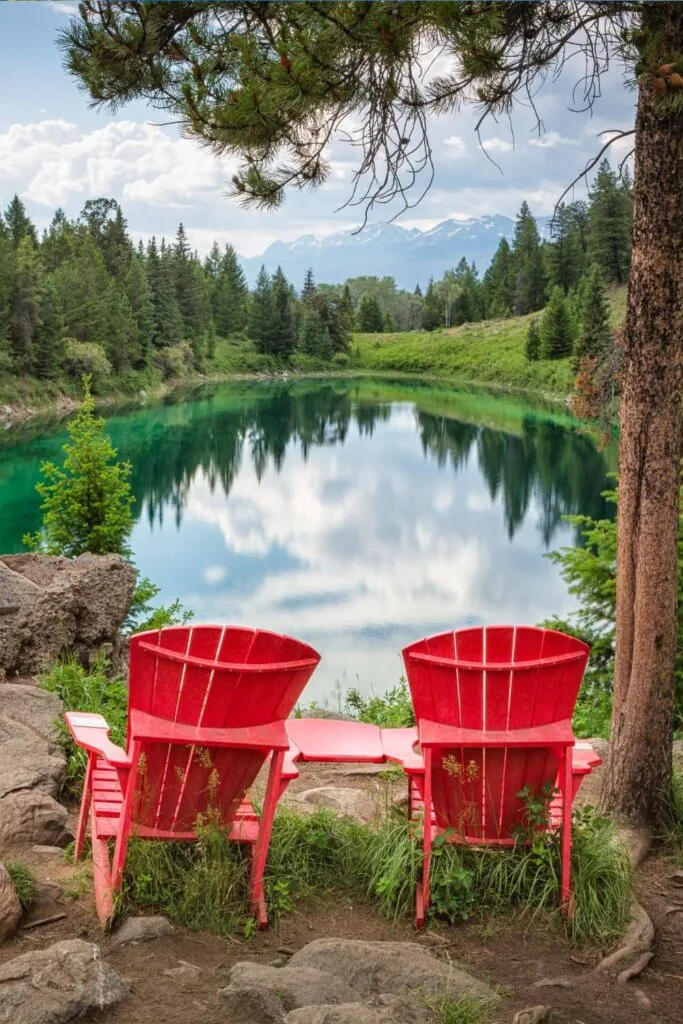
During the summer, visitors can see moose, waterfowl, and bears. The 2.3 km trail is suitable for most, even those without any hiking experience.
What You Should Know
- Once you leave Banff or Lake Louise, there is no cell phone coverage.
- There is only one gas station at the Saskatchewan Crossing between Banff and Lake Louise.
- Vehicles must have snow tires to drive the Icefields Parkway in winter and some roads won’t be accessible.
- Winter road conditions can be treacherous. Check on the weather and road before starting your journey.
- You need to purchase a Discovery Pass to access the Icefields Parkway. As of January 2022, the Pass costs CAD 10.50 a day, CAD 72.25 for an annual pass (per person), or CAD 145.25 for a yearly group pass.
- While Banff National Park has fences along the highway, Jasper does not. Be on the lookout for animals at all times.
- With a long drive and many potential stops, make the most of your day by planning an early start.
National Geographic rated the Icefields Parkway as one of the world’s most scenic roadways. After your first visit, I’m sure you’ll agree.
With many options for stops along the way, expect a busy itinerary filled with jaw-dropping landscapes. Once you reach Jasper, consider spending 3 days exploring the national park for more incredible views, lakes, and wonderful hiking trails.
While the twenty stops listed can’t be managed in a day, plan your stays to coincide with your planned route. So, are you prepared for this drive of a lifetime?
